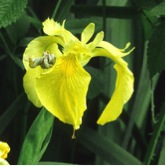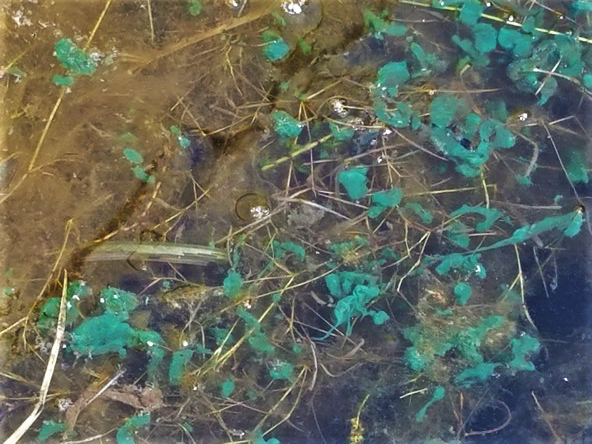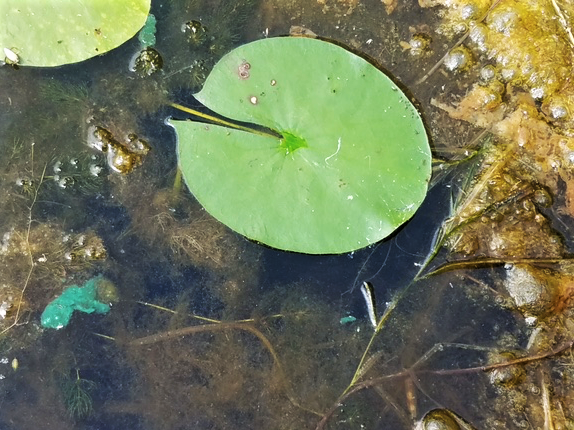LAKE MANAGEMENT - LAKE SURVEYS AND COMPREHENSIVE MANAGEMENT PLAN
AIS PREVENTION - Landing Monitors (at Public Landings)
SCLA volunteers work to secure WDNR grants that help fund the cost of “landing monitors” (aka boat inspector/educators at boat launches) at the two public boat landings. Landing monitors are the best defense against the introduction of new aquatic invasive species such as Eurasian Water Milfoil (EWM). The monitors teach visitors how to protect the lake by cleaning their boats and trailers prior to launch. They are critical to our work to prevent the two most devastating invasive species: EWM and its more aggressive cousin, Hybrid Watermilfoil (HWM).
- Point Intercept Studies are also supported by WDNR grants and SCLA funds and are completed every 5 to 7 years. A Point Intercept Study includes raking a 2.5 square foot area of distributed points across each lake by a biologist - more than 1500 points in total for the Spider Lake chain. Each point is assessed for rake fullness and species found. Changes in the aquatic vegetation are then compared back to previous surveys. Substantial tracts of curly leaf pondweed (CLP) were detected in 2017: nearly 40 acres of measured bed size. Monitoring measures were implemented and fortunately the beds have since decreased in size.
- Water Quality Water quality influences the aquatic plant community, which can influence the chemistry of the lake. Water clarity, phosphorous, and chlorophyll-a are the metrics of water quality used to determine the productivity (“trophic state”) of the lake. These metrics have remained consistent over the past 30 years on the Spider Chain of Lakes. All Spider Chain lakes are mesotrophic in their classification of biomass productivity with intermediate nutrient levels and only occasional algae blooms. Shoreline preservation/restoration, buffer zones, and minimizing fertilizer and runoff are all actions homeowners can take to preserve the water quality of the lakes.
 COMPREHENSIVE LAKE MANAGEMENT PLAN (CLMP)
COMPREHENSIVE LAKE MANAGEMENT PLAN (CLMP)
The CLMP addresses lake water quality, habitat, aquatic invasive species prevention, and the framework to support the long term health of the Spider Chain of Lakes. The 10-year plan, which was approved in May 2022, will be implemented through 2032. SCLA is a leader among Wisconsin lake associations in this work to preserve and protect these irreplaceable resources. The cost of implementation of the actions recommended by the CLMP over the next 10 years ranges from $350,000 to $600,000. All of this preservation and protection will be made possible by generous donations and membership dues. See additional information on the CLMP here.
Four reports document the results of the study:
Spider Chain of Lakes CLMP FINAL 05232022.pdf
Shoreland Property Owners Survey Report_MAY 2021.pdf
Spider Chain of Lakes Nutrient Analysis-Final Draft.pdf
CLMP Shoreland and Shallows Habitat Survey 2020 (3).pdf
SCLA focuses on preventing, detecting, and responding to aquatic invasive species (AIS) by broadening the community's understanding of AIS threats through education, monitoring landings and lakes, and addressing invasive species through various strategies when needed.
Completed actions identified in the Spider Chain of Lakes Aquatic Plant Management Plan include:
• Shoreland restoration education and workshop,
• In-lake and shoreland invasive species monitoring,
• Clean Boats, Clean Waters watercraft inspections,
• Aquatic invasive species rapid response plan,
• Curly leaf pondweed and purple loosestrife monitoring,
• Dissolved oxygen monitoring (profiles on Spider and Little Spider),
• Take Action Against Yellow Flag Iris campaign
• Spider Lake Environmental Education for Kids (SLEEK) program
• Native plant sales
• Project Pike – to remove northern pike (an introduced species) from the lakes
MEANDERING SURVEY
In addition to the 2021 CLMP (approved in 2022), SCLA has regularly procured a "MEANDERING SURVEY" conducted by biologists to identify important metrics of the chain of lakes.
AQUATIC PLANT STUDIES
Point Intercept Studies for the Spider Chain of lakes are below.
Spider Lake - Point Intercept 2017.docx (Big Spider and Little Spider Lakes)
Clear Lake - Point Intercept 2017.pdf
Fawn Lake - Point Intercept 2017.pdf
North Lake - Point Intercept 2017.pdf
LAKE MONITORING BY VOLUNTEERS
SCLA lake monitors and residents are our eyes on and in the water. If you see any vegetation or aquatic creatures which appear 'unusual', please let us know by clicking here for SCLA's RAPID RESPONSE PLAN and contact Dave Mickelson (715) 828-1878 or davemickelson51@gmail.com. Go to Lake Monitoring page for details on how to become a lake monitor.
“It is the boaters who use our landings that will determine what our lakes will look like in future years.” Jim Brakken
Invasive species are a threat to native ecosystems, outdoor recreation, local businesses, and the value of our lake property. The Spider Chain of Lakes is currently threatened by FIVE invasive species: Eurasian Water Milfoil (EWM), Hybrid Water Milfoil (HWM), Purple Loosestrife, Yellow Flag Iris (YFI) and Curly-Leaf Pondweed. Details on these species are below.
EURASIAN WATER MILFOIL (EWM) - not yet detected
The Spider Chain of Lakes is NOT infected with Eurasion Water Milfoil (EWM), although most of the surrounding lakes are battling this dangerous weed. EWM is one of the most devastating aquatic plants and is transmitted by hitching a ride on boats and trailers from an infected lake. EWM forms large, dense floating mats that prevent boat traffic, block sunlight which kills native aquatic plants and prevents larger fish from growing. It often leads to poor water quality and algae blooms giving the lake a “dead” look. We need to be vigilant about keeping this plant out of our lake, because there is no known method to eradicate it. Cleaning boats, waders, boots and jet skis BEFORE putting them in Spider Lake is what we ask of you and your guests. Help us keep Spider Lake free of EWM: If you spot a suspicious plant, call the SCLA Communication Coordinator listed the SCLA Rapid Response Plan below.
HYBRID WATER MILFOIL (HWM) - not yet detected
Hybrid Water Milfoil (HWM) is a combination of Eurasion Water Milfoil (EWM) and Northern Water Milfoil (a native, non-threatening plant). This hybrid grows to extreme densities similar to EWM, is extremely fast growing and a major management concern. To confound matters, hybrid watermilfoil often does not respond to treatment strategies that effectively control Eurasion Water Milfoil. HWM resembles EWM in appearance but the only true determination is through scientific testing. Hybrid Water Milfoil is growing rapidly in Lost Land Lake and Lake Namekagon. If you spot a suspicious plant call the SCLA Communication Coordinator listed on the SCLA Rapid Response Plan below
YELLOW FLAG IRIS (YFI) - present
YFI is present in the Spider Lake Chain. It is a fast-growing and fast-spreading invasive which can outcompete other wetland plants, forming almost impenetrable thickets in much the same way that cat-tails do. Small clumps can be dug out, though this is only effective if the rhizomes are entirely removed. Mowed plants will regenerate from the rhizomes, so plants must be cut multiple times to exhaust their energy reserves. The sap may cause skin irritation, so gloves should be worn when handling cut or otherwise damaged stems.


WHAT YOU CAN DO TO Help:
- If you find Yellow Flag Iris, and the plant is accessible, remove the plant as follows:
-
- Wear gloves; skin irritation can occur with contact with plant roots.
- Clip flower heads and pull or dig out plants and roots.
- Place all plant material in garbage bags and take to Town Hall Solid Waste, at no charge.
- If you cannot access the roots of the plant, remove the flowers and seed pods (wearing gloves), bag the material, and take it to Town Hall Solid Waste, at no charge.
Tell us your property location, and site of Yellow Flag Iris on your property. We will ask volunteers to check your property and remove plants from your shoreline.
CURLY-LEAF PONDWEED - present
BLUE-GREEN ALGAE - seasonally present
Blue-green algae grow in every lake in Wisconsin. Clumps of blue-green algae that normally grow on the lake bottom have been floating to the surface of lakes in the Spider Chain. The good thing about these clumps is that they are easily noticed and therefore can be avoided, unlike other blue-green algae that grow as microscopic particles dispersed throughout lake water. These latter kinds of blue-green algae, which grow to nuisance levels known as blooms that discolor water and form floating scums, are not what are growing in the Spider Chain. However, the same precautions that keep people safe from blue-green algae blooms would also apply to these clumps of blue-green algae.
Some blue-green algae can potentially make toxins that can make people and animals sick if they swallow lake water containing blue-green algae or if they inhale blue-green algae in water droplets, as might happen if they water ski through a heavy accumulation of blue-green algae. Some people may be susceptible to rashes and other irritation from skin contact with blue-green algae, such as if it is rubbed against the skin under clothing.
The floating clumps of blue-green algae in the Spider Chain are easily seen because of the bright blue-green color, and thus it's easy for people to avoid swimming in areas with high densities of the clumps and avoid accidentally swallowing them. Dogs won't necessarily avoid the clumps of blue-green algae, so it is important for pet owners to prevent their dogs from ingesting the clumps via drinking the lake water, eating any material that may be washed up on shore, or licking it from their fur after swimming.


You cannot tell if accumulations blue-green algae are producing toxins just by looking at them, so be wary of any high concentration of blue-green algae in water, whether it is dense accumulations of microscopic particles that discolor the water or areas with high concentrations of floating clumps of blue-green algae.
Even if water is clear, it’s always a good idea to avoid swallowing any untreated surface water because it can contain blue-green algae, bacteria, viruses, or parasites that can make people and animals sick.
Blue-green algae are easily moved around by wind and currents. The location and density of these blue-green algae clumps in the Spider Chain will likely change daily until they eventually dissipate, so it is important for you to assess conditions for yourself before swimming or participating in other water recreation.
If you use common-sense precautions, you can safely enjoy recreation on Wisconsin’s lakes and rivers:
- Choose locations without noticeably green water for swimming, because wind can concentrate blue-green algal blooms into near-shore areas. Do not swim in water that looks like "pea soup", green or blue paint, or that has a scum layer or puffy blobs floating on the surface.
- Do not boat, water ski, etc. over water that looks like "pea soup", green or blue paint, or that has a scum layer or puffy blobs floating on the surface (people can be exposed through inhalation).
- Do not let children play with scum layers, even from shore.
- Always take a shower after coming into contact with any surface water (whether or not a blue-green algae bloom appears to be present; surface waters may contain other species of potentially harmful bacteria and viruses).
- Always avoid swallowing untreated surface water – it may contain pathogens other than blue-green algae which could make you ill.
It's important to choose the clearest water possible for dogs to swim in, and to keep dogs out of areas with algae accumulations or dense particulate matter that might be blue-green algae.
There is additional information about blue-green algae at the DNR’s website and at the Wisconsin Department of Health Services website:
- Always wash dogs off with clean water immediately after they swim, so they cannot lick off any algae clinging to their fur.
- Do not allow dogs to eat any algal scum that may have dried on the shoreline or floating mats of algae.
- If there’s any doubt about what is in the water, keeping dogs out is the safest course of action.
PURPLE LOOSESTRIFE - present
Numerous strands of this very harmful aquatic plant exist on the shoreline of Clear Lake and Big Spider Lake. When purple loosestrife invades, it impacts the lake by forming thick stands that prevent recreation, displacing fish from the shelter where they reproduce and rear their young, and crowd out native aquatic plants and insects which upsets the entire ecosystem.
PREVENTION AND ERADICATION OF INVASIVE SPECIES BY SCLA - CHECK YOUR OWN PROPERTY REGULARLY!
To prevent further spread of invasive species into the Spider Chain of Lakes, we pay for launch monitors at public boat landings to inspect boats and trailers entering the lake. Launch monitors are our first line of defense in preventing the introduction of new invasive species into Spider Lake. In addition to inspections, launch monitors provide AIS information, collect and report data, and report suspect specimens.
We also conduct shoreline inspections three times per summer. During the summer and fall, SCLA volunteers investigate the entire shoreline by boat, canoe, or kayak. Our volunteers are trained to identify invasive species, and we work with the DNR to record current stands to measure the effectiveness of our projects. If you would like to be a volunteer lake monitor, please contact us at spiderchainoflakes@gmail.com. For details on the Lake Monitoring Protocol click here.
SCLA is working to control Purple Loosestrife infestation. In early spring, the plants are dug up by volunteers who remove plants from the lake and also create small nuseries for the Gallerucella beetle. SCLA volunteers raise over 40,000 beetles that are then transferred to the stands on Clear Lake. The Gallerucella beetle is a native predator of the loostrife plants and eats the new seedlings before they can take root for a new growing season. After eight seasons of release a reduction in the size of the stands was observed.
Aquatic Plant Management Plans:
“The High Cost of War,” by Jim Brakken of the Bayfield County Lakes Forum
LEARN MORE ABOUT INVASIVE SPECIES
Eurasion Water Milfoil in Sawyer County Lakes
Curly Leaf Pondweed - WI DNR
Eurasion Milfoil - WI DNR
Purple Loostrife - WI DNR
Aquatic Invasive Species Video
